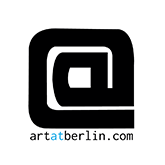PROLOGUE | PERSONAL
Anja, imagine you would welcome us in your studio or home. Where do we talk together, where do we meet you? When I have visitors, I prefer to welcome them in the large room of our “Werkhaus” – at a long, self-made table crafted from beech wood with a narrow tabletop to create a sense of closeness while talking.
The building is now called the Werkhaus – a place where living and working merge. Here, I always feel a bit anglophile, almost as if I were in a London studio – except it’s located in Halle-Kröllwitz, in a former duplex with red brick and pink and green doors.
My husband and I renovated it ourselves so that studio life and family life could coexist under one roof. I love this place because it unites my work and life. Everything here has been shaped by our own hands.
Fig.above: Portrait Anja Nuremberg, G7 Anja with canvas
Perhaps we are sitting in your favourite place?
Perhaps we’re sitting with a steaming cup of tea on the adjoining gallery, just a few steps above the open kitchen. From here, you have a wide view across the entire space.
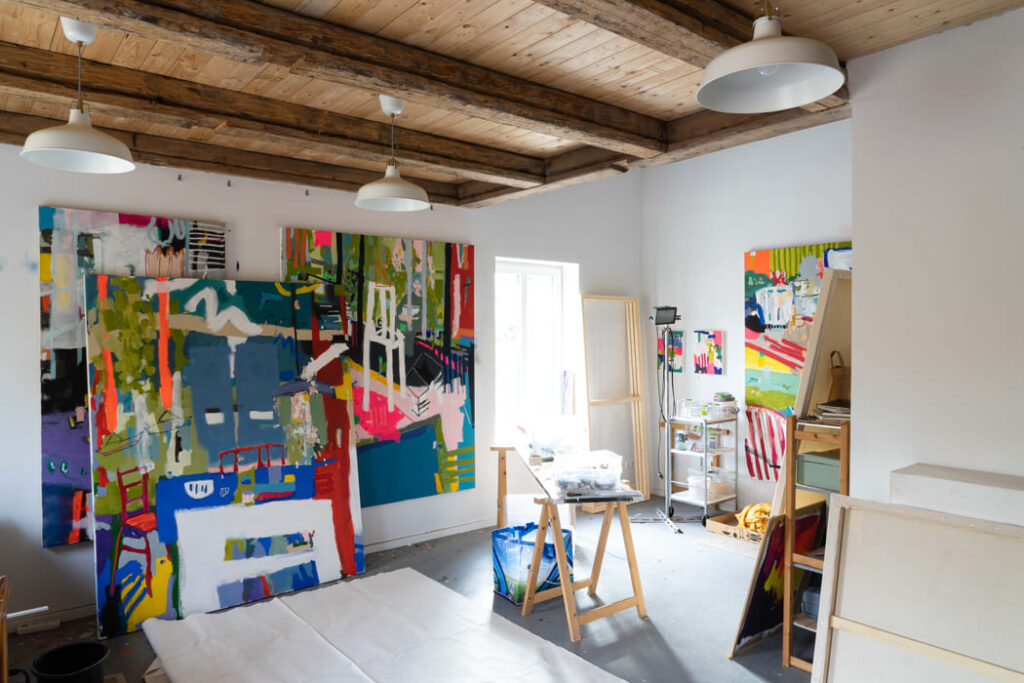
You were born in 1982. Please tell us where you were born and grew up and which stages and people have particularly influenced you in your life so far.
I was born in 1982 in Magdeburg and grew up in Berlin-Hohenschönhausen – in a neighborhood of prefabricated buildings with its own kind of poetry: uniform facades, long shadows between buildings, lots of concrete, yet also light.
My childhood was shaped by a daily life between order, concrete playgrounds, and pine-scented garden moments with my grandparents in Magdeburg.
I belong to the so-called “Third Generation East” – a generation that spent its childhood in a fixed system and suddenly found itself in an open but uncertain world as teenagers. This upheaval deeply shaped me. Not as a political issue, but as an inner experience: the feeling that something established was tipping over and one had to look and think anew.
A formative year I spent as a student in Ireland, later studied Business Administration in California, and worked for a Berlin start-up at Hausvogteiplatz – an exciting glimpse into a completely different world. But eventually, it became clear: I needed color, openness, and process.

That’s when I consciously returned to what truly moves me and studied Art at Burg Giebichenstein University of Art and Design in Halle.
Besides my studies, stays in Ireland, southern France, Italy, and the Baltic Sea have deeply inspired me – places where light and silence speak their own language. Yet, not only places, but also people have shaped me: my family, especially my grandparents, and many companions and artist friends who have given me both resonance and friction
And last but not least – my husband and our two children. They are not a backdrop but part of my artistic thinking. They remind me daily that life itself is the greatest space for experience.
Which writers do you find exciting at the moment and which books can be found on your bookshelf?
I’m a fan of Ewald Arenz, Benjamin Meyer, currently Eva Lohmann, and Joachim Meyerhoff. My bookshelf is filled with books dealing with memories, moods, and inner landscapes – less about grand plots, more about the in-between spaces.
Additionally, many art books are part of my collection – about Pierre Bonnard, Matisse, Helen Frankenthaler, or more contemporary positions like Monika Michalko’s “Here in the real world” or Katharina Grosse’s “Studio Paintings,” which inspire me both formally and in terms of content. For me, they are not reference works but conversation partners – visual pauses for thought amid everyday life.
Which books have influenced or shaped you?
The novel “The Offing” by Benjamin Myers.
What are you currently reading and where does the book lie at hand?
“Dopesick” by Beth Macy (everyone should read it!) and alongside it “Wie du mich ansiehst” by Eva Lohmann.
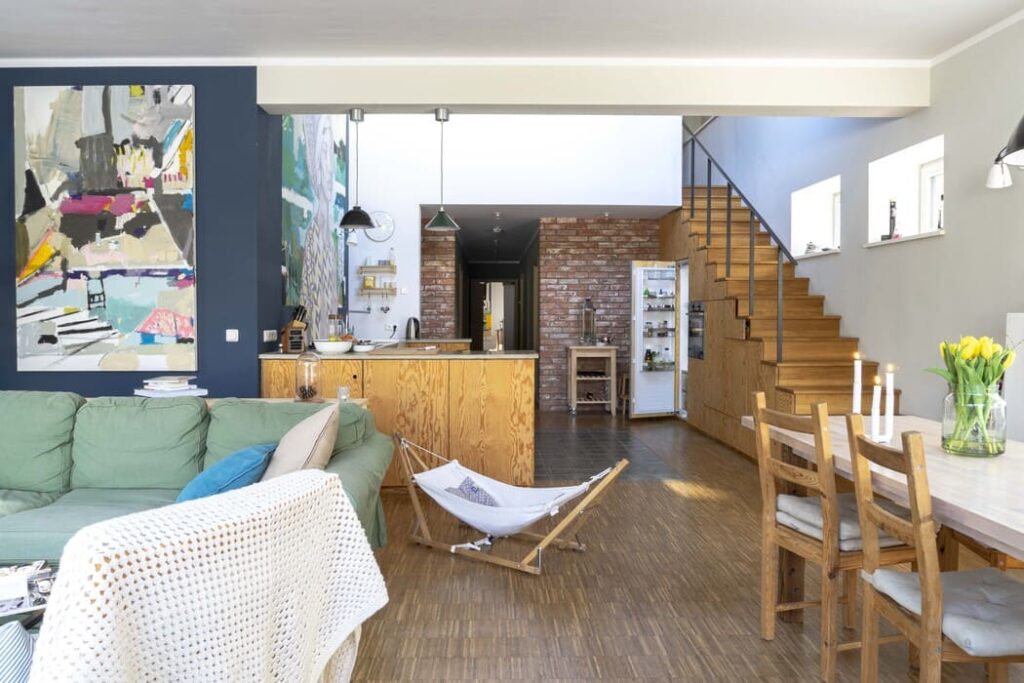
What music do you listen to and when?
It depends on my mood: while painting, I like Britten or Chopin because they help me focus. Måneskin is perfect for defiant moods, Andrew Bird for stories in between. And when things get too serious, Grönemeyer or Funny van Dannen’s quirky humor save me. Music reflects my daily mood – just like art.
If you were to cook something for us, what would it be?
It’s spring, almost summer. Spontaneously – crispy grilled salmon with cucumber-yogurt.
What is your favourite food?
I’d rather not commit to just one. I love good food and enjoy cooking passionately. Small, refined compositions fascinate me. We experiment a lot.
What do you think about breakfast?
On weekends, breakfast is almost a ritual for us – family time, good coffee, everything a bit slower. During the week, it’s more of a luxury that rarely happens.

What kind of sport or compensation do you do for your artistic work?
Cycling is my daily balance – sometimes alone, sometimes with our little son as co-pilot. And water draws me in magically: I love water sports, even if I’m still more of a learner there. But the desire to learn more is definitely there.
Do you have any special passions (hobbies) that you are passionate about, and if so, which ones?
love getting things off the ground together – especially with young people. Projects where it’s not just about the result but the journey: brainstorming, getting things done, growing together. This energy gives me a lot in return.
What personality trait particularly defines you?
I’m a doer.
Do you have a concern that you would like to share with us? Or an answer to a question (not asked by us) that currently moves you?
I wish for more real encounters – without constantly looking at our phones, but with genuine interest in each other. These small, honest conversations make all the difference for me.
INTERVIEW | ARTIST + POSITION
We would like to briefly introduce your artistic career. You initially studied International Business Administration in Germany and the U.S. from 2002 to 2005, completely unrelated to art. From 2008 to 2013, you then studied at Burg Giebichenstein University of Art and Design Halle, specialising in painting + graphics. Please tell us about this switch and probably other stages in your artistic career.
We would like to briefly introduce your artistic career. You first completed a degree in International Business from 2002 to 2005 in Germany and the U.S. From 2008 to 2013, you studied painting and graphic arts at Burg Giebichenstein University of Art and Design in Halle. Please tell us how this change came about and share further stations of your artistic career.
After completing my international business studies and a few years of working, I realized: I don’t just want to optimize processes, I want to create – with my hands, with colors, with my own ideas. It was about moving things myself, not being moved. This longing led me to art. I then studied painting and graphics at Burg Giebichenstein University of Art and Design Halle. Since then, I regularly exhibit in galleries and municipal art spaces and have been represented at art Karlsruhe since 2022.
In 2022, I was awarded the Prize of the Art Foundation of Saxony-Anhalt – a recognition that underlines my artistic position.
How did you get into art? Why art?
I’ve been painting for as long as I can remember. I paint everywhere – in my mind, on paper, in the sand, or with sunscreen on my children’s bodies. Perhaps it all began when I sat with my grandmother by the German river Elbe during a picnic. She introduced me to art: as a city guide, as a museum companion, as a discoverer of colors, moments, and small places of happiness. These experiences carry me to this day.
Even when things get turbulent, I draw strength from these small moments – and from art. Every time I encounter art, I realize: people can create something truly wonderful.
What is currently making you happy?
Places of joy, celebration, and remembrance – those are my true sources of strength. When I paint, it’s exactly this feeling that drives me. Colors play the main role: a warming red, a joyful yellow, a calming blue. Colors awaken memories, bring back emotions, and make me feel alive in the best possible way. Without colors, I’d be lost.
What is currently scaring you?
I am concerned about how loud and fast everything has become – as if there is no room left for nuances. This constant overload of images, opinions, and expectations. I worry that we are losing the ability to really look closely, to see the important things in the small details.

Do you believe that art has a social responsibility? And what do you think it can achieve?
Yes, but not in the sense of a mission to educate or moralize. Art creates spaces where we can see things differently, feel anew, revive memories. It doesn’t force us, but invites us to look closer. Especially in times when everything seems fragmented, art can create connections – between people, generations, and ideas. For me, responsibility means not lecturing but opening up possibilities.
What characterises your art? What is your work about – what are the central themes?
My paintings are not depictions but spaces of experience. I’m interested in what happens between color, surface, and form – that indeterminate moment that only unfolds through viewing. I don’t want to explain anything but rather set things in motion. Memory plays a major role here: not as a rigid archive but as a living process. My art invites viewers to form their own inner images – like a kaleidoscope that changes with every movement. My background as part of the Third Generation East is tangible, even if not thematically in the classical sense. It’s about making the fragile visible before it disappears – not nostalgically, but openly, permeable, and very much in the present.
My art is a space for experience – not for explanation. I aim to make the fragile, fleeting, and movable visible. Memories, moods, moments: not captured, but in motion. I use painting to open spaces where viewers can connect with their own inner images. Color, surface, and form are not mere means to an end – they are the message themselves.
Introduce us to the work that exemplifies the message of your art or best embodies it from your perspective.
“Lightness with Bouquet” encapsulates much of what defines my painting: color as an emotional carrier, the fragmentary as a quality, and the interplay of surface and memory. It’s not about the sharp recognizability of a motif but about making a moment tangible. The painting tells of a seemingly casual moment – a table, a bouquet, light. Yet, within this lightness lies depth. Those who look closely will discover subtle shifts, hints, and gaps in the composition. This openness is important to me: the painting offers a space, but what happens within is decided by the viewer’s gaze. This is the core of my work: art as an invitation to personal remembrance.
How do you protect yourself from too much inspiration in today’s times?
I believe true inspiration needs emptiness. Honestly, achieving that emptiness doesn’t always work for me. I’m easily enthusiastic, I love getting lost in images, colors, and details. But I also notice that’s exactly when I need to step out – into the fresh air, onto my bike, into nature. That’s where many things sort themselves out naturally. It’s a constant balancing act between stimulation and calm.
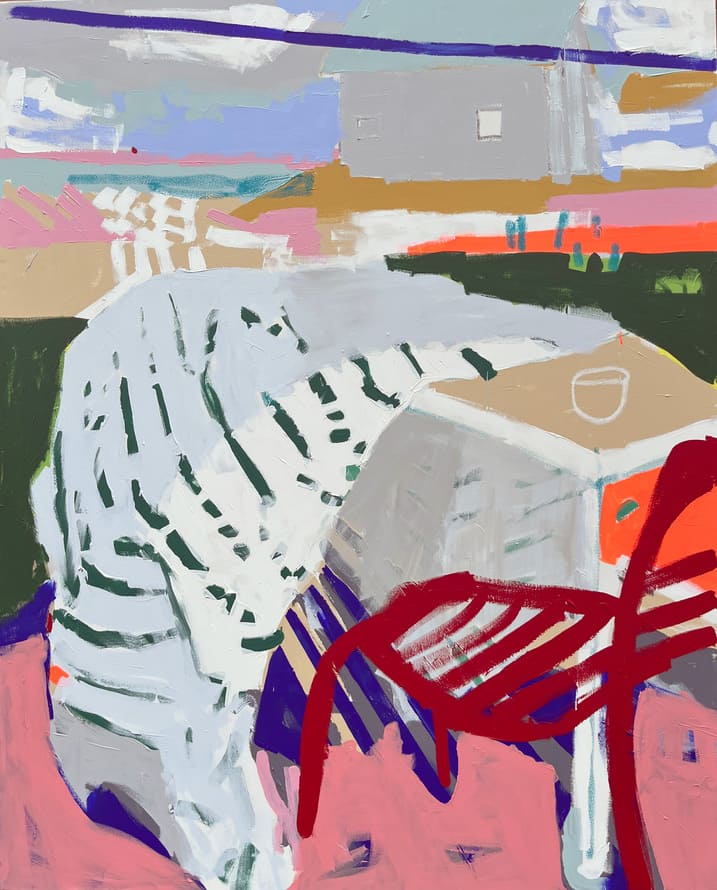
How much of your work is planned in advance – how much arises intuitively?
There’s never a finished plan at the beginning. Maybe I have a mood in mind, a feeling, a color combination – but the painting itself develops through the process. Intuition plays a huge role. Of course, there are technical decisions that are made consciously, but the truly exciting moments often happen unplanned. It’s a back-and-forth: letting go of control, observing, responding. That’s how every painting becomes its own unique experience.
What are your (next) goals?
I want to further increase the visibility of my artistic work – with exhibitions that don’t just display paintings but create real spaces of experience. At the same time, I’m intrigued by the idea of bringing art more into public spaces, taking it out of the classical white cube.
And personally? I’m drawn to the idea of further reducing my art – making the essential visible without having to tell everything. Maybe expanding my work with materials like wood and ceramics, to bring my painterly ideas into the spatial realm.
What is your position on the subject of faith? Do you have principles of faith or is there a motto?
For me, faith is less about religion and more about inner attitude. In Los Angeles, a Buddhist woman once gave me a mantra before meditation: ‘I am a happy little Buddha.’ Back then, I saw it as a kind gesture – today I know she gave me something very valuable: the reminder that serenity and joy don’t come from the outside, but start within myself.
Which project would you still like to realise if a lack of time, courage or financial resources did not play a role?
I’d love to work on a larger scale – literally. In painting, I dream of formats like those created by Julian Schnabel: monumental, space-filling, overwhelming. And in sculpture, I’m fascinated by that dimension as well, as felt in the works of Louise Bourgeois. Such projects require space, time, and courage. But one can always dream…
In your view, what are the attributes of good art?
I like honest art – no fudging, no over-intellectualized concepts that overshadow the work itself. Especially in painting, my belief is: painting should be painting. Not just a means to an end, not merely a vehicle for content. Color, form, surface – they should stand on their own. If a work is authentic, you can feel it immediately, like in the paintings of Katharina Grosse.

Is one born as an artist? Or is studying art compulsory?
I believe the artistic urge is something you carry within – this drive to question things, to create, to make visible. But talent alone isn’t enough. An art degree isn’t a must, but it offers space to experiment, to fail, to learn from others. For me, it was important to sharpen my artistic practice. However, what matters in the end is not the diploma but the mindset: curiosity, perseverance, and the courage to follow your own path.
How do you see the future of art in the age of AI?
The trace of a brushstroke remains the trace of a brushstroke. It tells the story of a human being, of a moment, of a real touch. For me, this imperfection is what makes it valuable. Art is not a data product.
What is your opinion on the topic of NFT?
I find NFTs exciting as a platform for digital art – finally, there’s a market that gives these works visibility and appreciation. However, when it comes to traditional painting, I’m critical. The trace of a brush, the materiality, the real encounter – these can’t be translated into digital form. NFTs are a great medium, but not suitable for everything.
Who do you show a new work to first?
My most honest audience: my family & close friends.
What does the first hour of your day look like?
Very down-to-earth: pure family life.
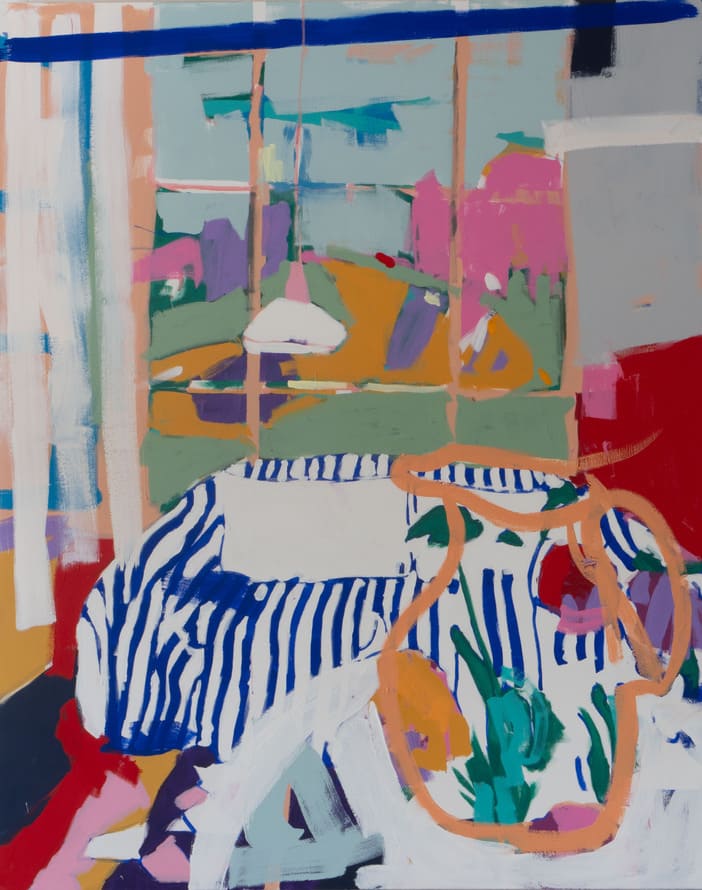
In the age of the Internet of Things, are galleries still necessary? If so, why and for what?
Absolutely. Art needs physical spaces to fully unfold its effect. A gallery is more than a place for sales – it’s a space of experience, a place for encounters, for dialogue. Online, I can see images, but I can’t truly experience them. The atmosphere, the light, the dimensions – all of that can only be felt in person. Especially in a digital world, such analog places are more important than ever.
Currently, I’ve collaborated with Sandra Schindler from Galerie Schindler in Potsdam on a reel about relationships. It’s precisely about this: the relationship between people and art – between collectors, artists, and gallerists. These connections can be told digitally, but they can only truly be experienced in direct contact.
Social media – blessing or curse?
Social media is a tool. It can open doors, make art accessible, and spark real encounters. But it also tempts us to merely consume image floods without truly engaging. For me, the challenge is to preserve depth in a fast medium – not quantity, but resonance. Follow me 🙂
Read more about the artistic message of Anja Nürnberg in THE DEED | DAS WERK:
THE DEED | DAS WERK: Anja Nürnberg
The artist Anja Nürnberg, who was born in Magdeburg in 1982 and has lived in Halle (Saale) since 2008, talks about the central message of her artistic work.
Please describe the core theme and central message of your work.
My art is a space for experience – not for explanation. I am interested in visualising the fragile, the fleeting and the moving. Memories, moods, moments: not captured, but in motion. I use painting to open up spaces in which viewers can connect with their own inner images. Colour, surface and form are not a means to an end, but are themselves the message.
Introduce to us the work that you feel exemplifies or best embodies the message of your work.
„Leichtigkeit mit Strauß“ (Lightness with an ostrich) sums up much of what my painting is about: colour as an emotional carrier, the fragmentary as a quality, and the interplay of surface and memory. It’s not about making a motif instantly recognisable, but about making a moment tangible.
The picture tells of a seemingly incidental moment – a table, a bouquet, light. But it is precisely in this lightness that depth lies. If you look closely, you will discover small shifts, allusions and empty spaces in the composition.

This openness is important to me: the picture offers a space, but what happens in it is decided by the viewer’s gaze. This is precisely the core of my work: art as an invitation to remember.
What is the goal of your art, of your work – what is it supposed to do for the viewer?
My aim is to open up spaces for your own experiences – without guidelines, without a fixed interpretation. My art is not meant to explain, but to touch. I want people to pause when looking at my work and allow their own memories, moods and thoughts to emerge. I am less interested in the grand narrative than in the moment in between: the fragile, the fleeting, the intangible. I see my works as spaces of experience. They provide a direction, offer atmosphere, but leave open what is revealed in them. The picture is not the end of the story, but its beginning.
A good example of this is the work Leichtigkeit mit Strauß“ (Lightness with a bouquet) presented here. It shows an everyday scene: a table with flowers, fruit, hints of architecture and nature. But nothing about it is realistic in the classical sense. The colours play the leading role: bright yellow, vibrant red, delicate blue – they convey moods and make visible what cannot be put into words.
This openness is no coincidence, but an attitude. I consciously work with fragments, allowing things to resonate rather than defining them. For me, painting is not a means to an end, but a cosmos of its own made up of colour, surface and rhythm. I orientate myself on artists who thought in a similar way: Pierre Bonnard, who translated the everyday into pure painting. Or Joan Mitchell, whose abstract works are incredibly emotionally powerful. I am also guided by the phrase derived from Theo van Doesburg: ‘A line is a line. A colour is a colour.’ For me, this is not a dogma, but an attitude of honesty towards the medium. PAINTING!

I want my work to be understood as an invitation – not as a statement. In a world that is often loud and over-staged, my pictures are intended to be counterpoints: spaces for silence, for seeing, feeling and remembering. They don’t demand anything, but they offer something: a moment of pause that, at best, has a lasting effect.
I am not interested in nostalgic retrospection or political commentary. Although my background as part of the Third Generation East is part of my thinking, my art is not intended to provide contemporary testimony. It reflects atmospheres, inner movements, emotional topographies.
I see my work as open, permeable, breathing. Anyone who gets involved can discover their own resonance spaces. And for me, this is precisely where the greatest power of art lies: it doesn’t show what it means. It means what it shows – at the moment of viewing.
The question about THE DEED | DAS WERK is a supplementary and separately presented part of THE INTERVIEW IN|DEEDS with Anja Nürnberg. The translation was carried out by the DEEDS.NEWS team.
EPILOGUE | CURRENT
The solo exhibition Back to Green with works by Anja Nürnberg is currently on show at the Schindler Gallery in Potsdam. It can be seen from 15 May to 28 June 2025 in the gallery space at Charlottenstraße 86 in Potsdam.
Instagram: @anja.nuernberg.art
Website: www.anjanuernberg.de.
DEEDS interviews are not edited or abridged by our editorial team and are always reproduced in the original sound. We therefore do not translate the interview into English or German unless the interviewee submits a translation or we are commissioned to do so. In this case, the German and English versions of the interview were submitted by the artist herself.





